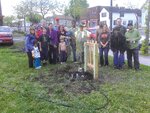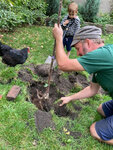By Patricia Ohmans,
Frogtown Green
Frogtown residents who have spent more than a decade working toward a goal of “1,000 Trees for Frogtown Homes” will reach – and surpass – that goal this year. What’s more, thanks to a federal grant, another 1,000 trees will be planted in Frogtown and Summit-University (St Paul neighborhoods with the lowest tree canopy) over the next five years.
Frogtown Green is a resident-led environmental initiative in St Paul’s most diverse low-income community. In 2011, volunteers with Frogtown Green vowed to plant 1,000 trees in their neighborhood’s front and back yards after learning how tree-deficient their neighborhood was. The “1,000 Trees” goal was suggested by neighborhood resident Seitu Jones, emulating the work of Joseph Beuys, a conceptual artist who planted 7,000 oak trees throughout the city of Kassel, Germany in the 1980s.
The Frogtown group – which inaugurated their efforts by planting exactly one tree on a vacant lot on Dale Street – included Jones and now-mayor Melvin Carter, then the area’s city council representative. Over time, and with the help of advisors from the city’s forestry department, the University of Minnesota, and eventually, the US Forest Service, the “Tree Frogs,” as they dubbed themselves, persevered. They gradually increased their output, pioneering a simple method of cultivating bare-root trees in gravel-filled community nursery beds along Dale Street.
As of this month, the Tree Frogs have distributed and planted 624 free shade and fruit trees in Frogtown homes. Add to that, a “mini-forest” of 600 trees slated for installation in a Frogtown Green-run community garden on Pierce Butler and Milton Street in late October, and Frogtown’s tree canopy will increase by 1,224 trees by the end of 2023.
“Our method for free residential trees is low-tech, but high-touch,” says Frogtown Green tree program director Chris Stevens, a Frogtown resident for 23 years. “This year, we flyered every single home in Frogtown to offer them a free tree. When we plant trees in people’s yards, we make all the arrangements, advise residents on tree selection and placement. All residents need to do is dig a hole on planting day and care for their new tree after that.”
From 2021 to 2023, the Tree Frogs also shared trees and their resident-driven techniques in three adjacent, low-canopy neighborhoods. The result: thriving, volunteer-driven programs in four neighborhoods and a grand total of 1,589 trees distributed and planted by residents in Frogtown, Summit-University, Hamline-Midway and Payne-Phalen. “Our partners each have slightly different methods, but we all concentrate on residential trees, and leave the boulevard trees to the city forestry department,” Stevens explains.
Stevens is sure that the demand for free trees will grow, noting a 50-person waiting list in Frogtown for this year’s trees. And thanks to a new partnership with Great River Greening – the recent recipient of a multi-million-dollar federal tree-planting grant – the supply of trees for Frogtown and friends will continue for another 1,000, through 2027.
“Frogtown Green has done an amazing job thus far, in an urban neighborhood that is among the hardest hit by tree losses. We are thrilled to partner with them going forward,” says Great River Greening executive director Kateri Routh.
Frogtown Green is a volunteer-powered initiative to build green beauty in the Frogtown neighborhood. We plant trees, cultivate gardens and work toward a healthier environment. If you’d like to know more, our website is frogtowngreen.com and our phone is 651-757-5970.




Comments
No comments on this item Please log in to comment by clicking here